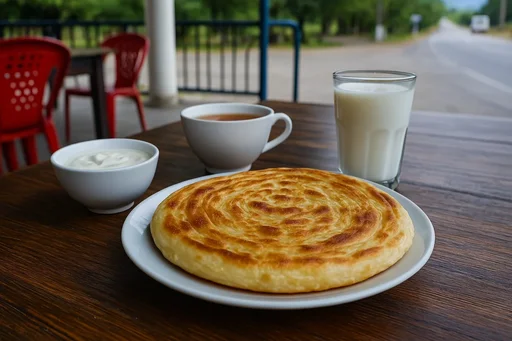In two days, we'll ascend to 3500-meter peaks, sit by the campfire in the heart of the Tien Shan range by Lake Son-Kul, and have an amazing time
- Duration: 2 days.
- Price: from 1000$ 790$ for group
- Group size: Small group tour

This is a special Kyrgyz flatbread. The basic ingredients (flour, water, salt, and oil) turn into a traditional aromatic dish of the nomads.
The word «qatlama» in Turkic languages means “layered” (from katlamak - “to fold, to bend”), and a nearly identical dish is found from Turkey to Pakistan, reflecting the wide spread of the recipe along the Great Silk Road.
Kattama traces its roots to the nomadic tribes of Central Asia - the Kazakhs and the Kyrgyz. Mentions of it appear in the chronicles of caravan travelers heading toward high-altitude Issyk-Kul. In southern regions of Kyrgyzstan, it is made at home, served in cafés, and sold at many street-food stalls along main roads.
According to legend, caravaners passing through the Boom Pass packed flatbreads of kattama into their saddles so that, thanks to its multilayer structure, it would remain fresh for several days.
It is believed that only honored guests should break kattama by hand - this brings prosperity to the household, while excessive use of a knife “breaks” the hosts’ good mood.
In 2019, a master chef from Bokonbaev held a kattama workshop at a gastronomic festival in Bishkek, introducing guests to the nuances of rolling out and baking the flatbread in the traditional kazan (cauldron).
Traditionally, kattama is baked in a kazan over sawdust or dried dung - a fuel source where firewood is scarce. The thick walls of the kazan create even heat, producing a crispy crust and a soft interior.
The dough is rolled so thin that the oil seeps through all the layers, forming juicy strata. It is this step that gives kattama its famous airiness and layered texture.
In 2022, the Chotkoraev family from Boom Gorge was invited to a gastronomic exchange in Abu Dhabi, where kattama became one of the hits on the menu of a five-star hotel.
Today, kattama is included in UNESCO culinary tourism routes across the Great Silk Road countries, and several cafés along the Bishkek–Issyk-Kul highway have received gastronomic awards for preserving the authentic recipe.
Kattama is served with broths, meat dishes, and tea with kaymak. It is eaten by hand, although filled variations are often served with a knife and fork.
In restaurants and street-food spots along the Issyk-Kul highway, you’ll find versions with cheese, spices, and various herbs. Despite the diversity of culinary traditions, traditionally prepared kattama remains the most common and beloved type of flatbread.
In two days, we'll ascend to 3500-meter peaks, sit by the campfire in the heart of the Tien Shan range by Lake Son-Kul, and have an amazing time
Forgotten Rivers and Mountain Peaks: A Journey Along the Southern Shore of Issyk-Kul is a three-day tour that immerses you in the unique natural beauty of Kyrgyzstan.
Experience all the beauty of Kyrgyzstan's nature behind the wheel of a comfortable and daring BMW F650GS tour enduro. These impressions are worth any money and will never be forgotten.
Visit two pearls of Kyrgyzstan in 1 day on a car tour
This route combines the picturesque mountain canyons of Kok-Moinok, Lake Issyk-Kul, the taste of national cuisine and a trip along one of the most beautiful roads in the country – the Boom Gorge.
Visit the Valley of the Seven Bulls, see Issyk-Kul and relax in the thermal springs